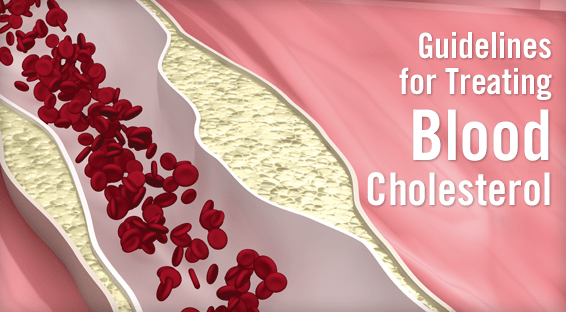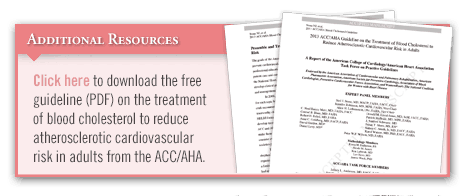In 2013, the American College of Cardiology (ACC) and the American Heart Association (AHA) released a new clinical practice guideline for the treatment of blood cholesterol in patients at high risk for atherosclerotic cardiovascular disease (ASCVD). The guideline was prepared by a panel of experts based on an analysis of the results of randomized controlled trials. The guidelines use the highest-quality scientific evidence to focus the treatment of blood cholesterol to those who are likely to benefit most.
A Focus on Statins
According to Neil J. Stone, MD, who served as chair of the expert panel that wrote the guideline, the ACC/AHA guidelines represent a departure from previous recommendations. “The guidelines don’t recommend specific target levels of LDL cholesterol,” he says. “Instead, they focus on defining patient groups for whom LDL lowering with statins has been proven to be most beneficial.”
The panel recommended use of statins after a detailed review of other cholesterol-lowering drugs. “Most statins are generics and have been shown to provide the greatest benefit while having low rates of safety issues when taken as prescribed,” Dr. Stone says. The guidelines note, however, that there is a role for other cholesterol-lowering drugs in selected patients who suffer side effects from statins.
The guidelines identified four major groups of patients for whom statins have the greatest likelihood of preventing stroke and heart attacks. Moderate- or high-intensity statin therapy is recommended for patients.
1. With clinical ASCVD.
2. With primary elevations of LDL cholesterol of 190 mg/dL or higher.
3. Aged 40 to 75 with diabetes and LDL cholesterol levels between 70 and 189 mg/dL without clinical ASCVD.
4. Without clinical ASCVD or diabetes who are aged 40 to 75 with LDL-cholesterol levels between 70 and 189 mg/dL and have an estimated 10-year ASCVD risk of 7.5% or higher, but only after a clinician–patient discussion.
The ACC/AHA guidelines provide physicians with risk assessment tools to help determine which patients would most likely benefit from being initiated on statins rather than focusing only on blood cholesterol levels (Figure). Dr. Stone adds that African-American ethnicity is now included on risk calculators to help clinicians more accurately determine which patients should receive statins to prevent stroke as well as heart attack. “This wasn’t true of older calculators,” he says. “Using the calculator allows for consideration of all risk factors and facilitates a risk discussion that includes patient preferences and assessing statin efficacy and safety before a prescription is given.”
Heart-Healthy Lifestyle
The adoption of a heart-healthy lifestyle is critical to preventing and controlling high blood cholesterol, according to Dr. Stone. “The cornerstone of all guidelines dealing with cholesterol is a healthy lifestyle.” This is particularly important in younger patients who are at risk for high cholesterol later in life. The guidelines note that for patients who already have ASCVD, lifestyle changes alone will not be enough to prevent heart attacks, stroke, and death, meaning that statin therapy will be necessary.
Making an Impact
The likely impact of the ACC/AHA recommendations is that more patients who would benefit from statins will be started on these therapies, says Dr. Stone. “The key word is ‘benefit,’” he says. “It’s unlikely that the new guidelines will lead to substantially more patients taking statins. Instead, the guidelines will help clinicians refocus on those who can benefit most from statin therapy based on the evidence. They also provide a blueprint to help physicians decide who merits a higher dose of statins to derive greater benefit.”
For many years, the focus on managing blood cholesterol in ASCVD patients has been to get LDL levels low by any means. “How we get LDL levels low is important,” Dr. Stone says. “The guidelines support the concept of proven therapy.”
Some patients who do not fall into the four major categories may also benefit from statin therapy. Factors such as family history of premature ASCVD, LDL-cholesterol of 160 mg/dL or higher, and other suggested factors can help physicians make treatment decisions in selected cases. “The two therapies for ASCVD that have proven to be most effective are a heart-healthy lifestyle and statins,” says Dr. Stone. “Implementing these guidelines will help to substantially address the large burden of ASCVD in the United States. In the future, we anticipate that gaps in the guidelines will be filled with high-quality trial data to better inform treatment decisions.”




 TimH
TimH